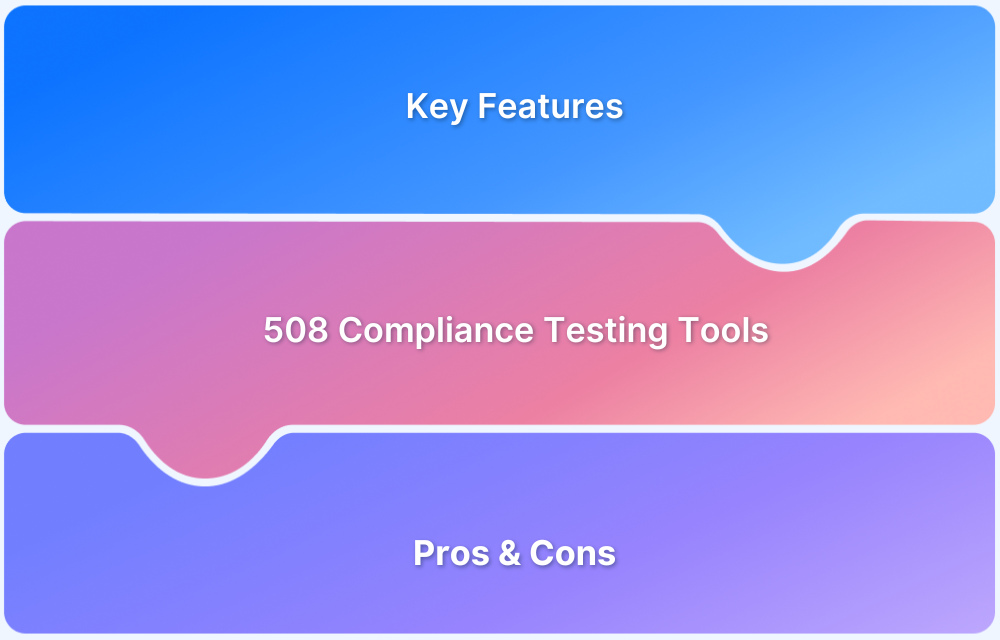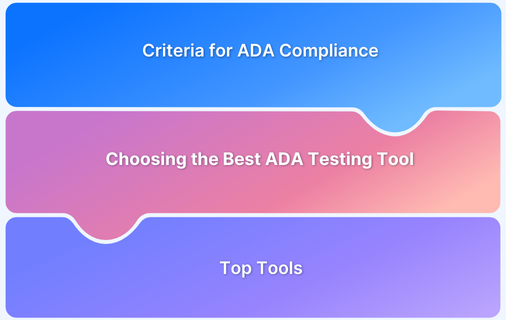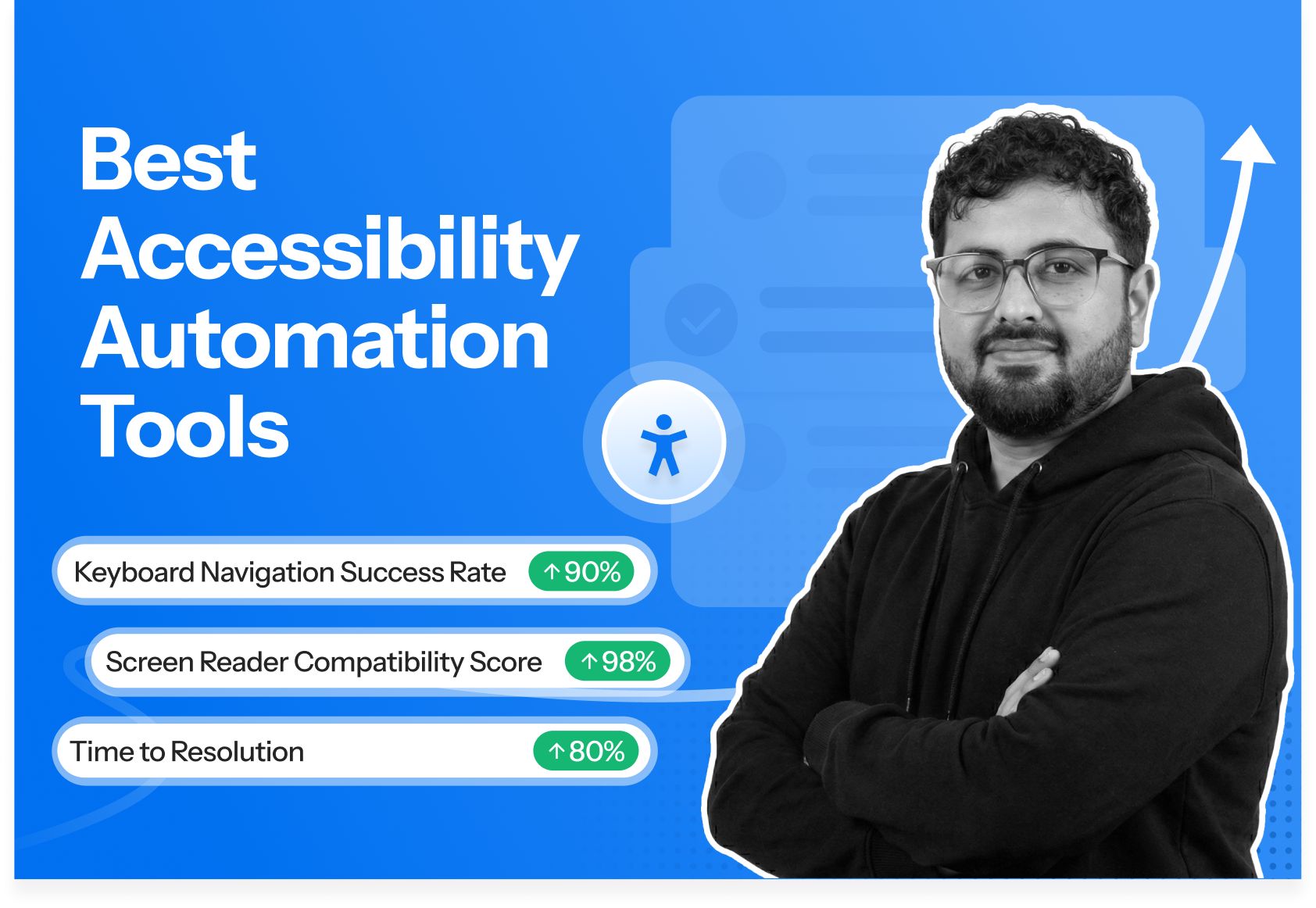Section 508 requires digital content to be accessible to people with disabilities so federal agencies and vendors meet legal standards.
Overview
What Is Section 508?
Section 508 is a U.S. law that requires federal agencies and vendors to make digital content accessible to people with disabilities. It requires text alternatives for images, keyboard navigation support, sufficient color contrast, and accessible documents, websites, and software.
Top Section 508 Testing Tools
These tools help you identify and fix accessibility issues so your digital products meet Section 508 requirements.
- BrowserStack: Test accessibility on real devices and browsers in the cloud to validate compliance in real-world conditions.
- Pa11y: Open-source tool that runs automated accessibility checks and generates reports.
- Lighthouse: Free Chrome tool that audits web pages for accessibility and other performance metrics.
- Accessibility Insights for Web: Free Microsoft tool offering automated checks and guided manual tests.
- AChecker: Web-based tool that checks HTML content against accessibility guidelines, including Section 508.
This article covers the leading Section 508 testing tools in detail so you can compare and choose the right one for your business.
What Is Section 508?
Section 508 is part of the Rehabilitation Act of 1973 in the United States. It requires federal agencies and organizations that provide services to them to make electronic and information technology accessible to people with disabilities.
The law ensures that individuals with vision, hearing, motor, or cognitive disabilities can use websites, software, documents, multimedia, and other digital tools. In 2018, Section 508 was updated to formally adopt the Web Content Accessibility Guidelines (WCAG) 2.0 as the standard for websites and web applications.
What Does Section 508 Require?
Section 508 sets specific standards for digital content to ensure accessibility for people with disabilities. These requirements apply to websites, software, documents, and multimedia.
Key requirements of Section 508 compliance include:
- Follow WCAG 2.0 Level AA standards for websites and web applications.
- Provide alt text for images, charts, icons, and other non-text elements.
- Include captions, transcripts, or audio descriptions for video and audio content.
- Ensure full keyboard access for all interactive elements.
- Support compatibility with assistive technologies like screen readers and magnifiers.
- Use clear headings, labels, and instructions for forms and controls.
- Ensure sufficient color contrast between text and background.
- Avoid content that flashes or blinks in a way that could trigger seizures.
- Make electronic documents (like PDFs and Word files) accessible.
Top Section 508 Testing Tools
The right tools help identify and fix accessibility issues so your digital content meets Section 508 requirements.
1. BrowserStack
BrowserStack is a real device cloud platform that lets you test websites and apps on 3,500+ real devices and browsers. It helps teams validate accessibility under real user conditions without managing device labs. You can combine automated and manual testing and integrate with CI pipelines to make accessibility checks part of your workflow.
Key Features of BrowserStack Accessibility:
- Real device cloud: Run accessibility checks on actual devices and browsers without relying on emulators.
- Screen reader support: Test with NVDA, VoiceOver, and TalkBack in live sessions to validate non-visual navigation.
- Keyboard navigation testing: Verify that your site works with keyboard-only input and follows a logical focus order.
- Automated testing: Run automated accessibility scans based on WCAG and Section 508 across complete journeys and interactions.
- Centralized reporting: Get detailed accessibility reports with logs, screenshots, and videos to support faster debugging and compliance tracking.
Benefits of BrowserStack Accessibility:
- Real device access without maintenance overhead: BrowserStack lets you test on a wide range of real devices and browsers without the hassle of setting up or maintaining a physical lab.
- Manual and automated scans in one platform: BrowserStack allows you to combine manual checks with automated accessibility scans in the same workflow. This helps you identify both evident and subtle accessibility issues so your product works well for all users.
- Stay aligned with changing standards: BrowserStack updates its platform as accessibility laws evolve and new operating systems or devices are released. This ensures your testing reflects the latest requirements and real-world environments.
- Validate design and layout choices: You can verify critical details like font sizes, color contrast, orientation, and element spacing to ensure your site or app is usable by people with vision, motor, or cognitive disabilities.
2. Pa11y
Pa11y is an open-source tool that runs automated accessibility checks against web pages. It helps teams quickly identify issues based on WCAG and Section 508 standards. Pa11y can be run in the terminal or integrated into CI workflows and supports generating reports in various formats.
Key Features of Pa11y:
- Automated scanning: Run accessibility tests based on Section 508 and WCAG to detect common issues.
- Command-line interface: Use in terminal or scripts for easy integration into automated workflows.
- Report generation: Export accessibility reports in formats like JSON or HTML for review or documentation.
Limitations of Pa11y:
- Headless environment only: Runs in headless browsers, so it does not reflect styling or behavior seen on full browsers or devices.
- Requires technical setup: Developer knowledge is needed to configure and use it effectively.
- Limited guidance on fixes: Highlights issues but does not provide detailed instructions for resolution.
3. Lighthouse
Lighthouse is a free, open-source tool built into Chrome that audits web pages for performance, best practices, SEO, and accessibility. It provides a quick way to check for common accessibility issues and generates a detailed report.
Key Features of Lighthouse:
- Quick automated audits: Checks against Section 508 and WCAG criteria for common issues.
- Easy access in Chrome: Runs directly from DevTools or as a Node module.
- Clear scoring system: Generates an accessibility score and highlights areas for improvement with specific suggestions.
Limitations of Lighthouse:
- Surface-level checks only: Primarily detects common patterns and misses complex interaction issues.
- No multi-page or flow testing: Audits one page at a time and lacks support for end-to-end journey coverage.
- No real assistive tech checks: Does not simulate screen readers or test actual keyboard interaction beyond basic focus.
4. Accessibility Insights for Web
Accessibility Insights for Web is a browser extension that provides both automated and manual test guidance for accessibility.
Key Features of Accessibility Insights for Web:
- Automated scanning: Runs quick accessibility checks based on Section 508 and WCAG standards.
- Manual test guidance: Provides step-by-step instructions to help catch issues that automated checks miss.
- Issue tracking: Allows you to log issues and export findings for sharing or documentation.
Limitations of Accessibility Insights for Web:
- Limited browser support: It works only in Chrome and Edge, so if you want to test in Firefox or Safari, you will need other tools.
- No built-in automation: Designed for manual testing and does not support CI/CD integration.
- Single-page focus: Designed for testing individual pages and does not support multi-page flows or journeys.
5. AChecker
AChecker is an older, web-based tool that analyzes HTML content against accessibility standards.
Key Features of AChecker:
- Checks static HTML: Lets you paste code or enter a URL to review accessibility of static web pages.
Read More: What is Static Testing?
- Multiple standards support: Can test against Section 508, WCAG, and other selected guidelines.
- Categorized issues: Groups results as known, likely, or potential issues to help prioritize fixes.
Limitations of AChecker:
- Outdated standards: The tool is no longer actively maintained, so it may not reflect the latest accessibility guidelines or browser technologies.
- Cannot test dynamic content: Only evaluates static code and does not detect issues in content or features that load after the initial page render.
- No automation or integration: Offers no support for CI pipelines or automated accessibility checks during development.
Why Choose BrowserStack for Section 508 Testing?
Most tools offer simulators or emulators that can miss real-world accessibility issues and do not reflect actual user environments. They lack the accuracy to validate real-world accessibility issues like incorrect focus order, improper touch target sizing, unreliable screen reader behavior, or platform-specific contrast problems.
BrowserStack Accessibility fills this gap by offering real devices and browsers where you can test accessibility features as users experience them. This helps you verify Section 508 compliance across Windows, macOS, Android, and iOS and deliver an inclusive digital experience.
You can also integrate BrowserStack with automated accessibility tools or manually check features like keyboard navigation, color contrast, and screen reader compatibility on real devices. This helps ensure your website or app meets legal requirements and works well for users with disabilities.
Conclusion
Section 508 requires digital products, including websites and applications, to be accessible to people with disabilities. Testing your website and app helps confirm that your content meets these legal standards across platforms and devices. BrowserStack provides access to over 3,500+ real devices and browsers to test in conditions that match how users experience your product.






